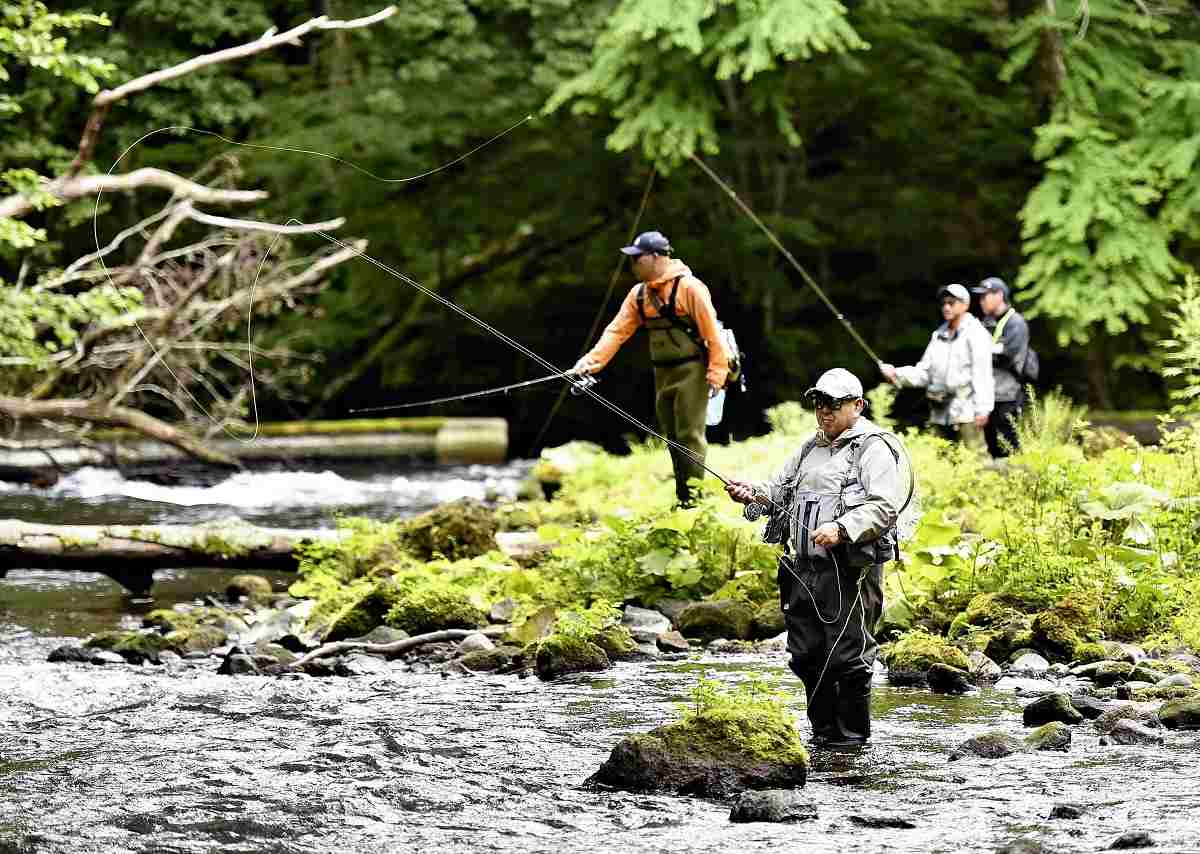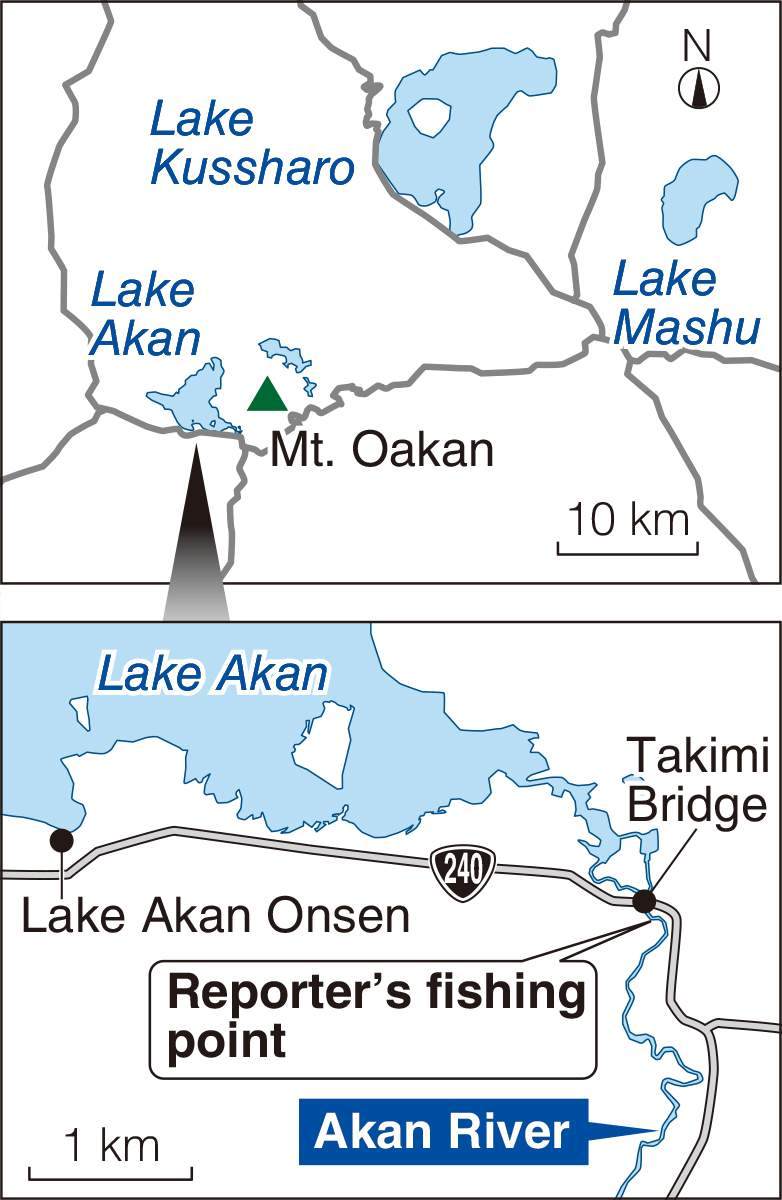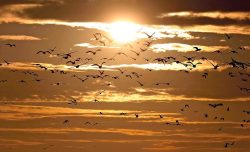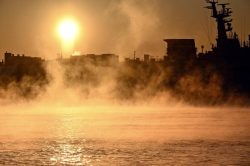Hokkaido Travel Adventures / Akan River, A ‘Sacred’ Trout Fly-fishing Spot, Touted As Potential Tourist Magnet

Fly-fishers try their luck in the Akan area of Kushiro, Hokkaido, on July 19.
6:00 JST, October 9, 2023
This is the fourth installment in a series exploring the charms of Hokkaido, an area rapidly garnering attention as an ideal holiday destination.
***
Akan River flows from Lake Akan — known for its marimo algae balls — in Kushiro, Hokkaido, all the way to the Pacific Ocean. On a day this summer, anglers could be seen fishing along the river near Takimi Bridge on National Highway Route 240.
The forest canopy-filtered sunlight lit up the river surface as anglers cast their lines tipped with fish-enticing artificial flies.
It was my first time to try fly-fishing, and my excitement was all the greater because the river is revered as “sacred” by many anglers.

A large rainbow trout caught in the Akan River
I was targeting rainbow trout, so-named for their colorful bodies. Akan River trout average around 45-50 centimeters in length, though specimens measuring over 70 centimeters are also occasionally hooked.
I have tried some river fishing before but it was the first time for me to use a fly. I was grounded in the technique by 24-year-old Junpei Matsuoka, a fishing tour guide working out of the Tsuruga resort in Kushiro.
Fishing flies are usually categorized into two types: dry flies, which resemble insects and are designed to float on the water surface; and wet flies, which sink below the surface.
Anglers choose flies based on the predatory behavior of the targeted species, repeatedly casting their lines in graceful arcs to allure their prey.
“Rainbow trout are smart,” Matsuoka said. “If the behavior of the [anglers’] flies is even slightly different from that of real-world insects, the fish instinctively avoid taking a bite.”

When one particular trout showed interest in my lure, I jerked my rod-tip skyward and hooked the fish in the mouth. It splashed around vigorously, straining the line. “It’s battle-time!” Matsuoka enthused.
As the fish fought, my rod bent dramatically, and I realized that if I tried to land it too quickly, the hook could dislodge, or the line could break. Prior to this particular piscine confrontation, I had spent an unfruitful two hours, enduring four or five unsuccessful attempts to land a fish.
However, on this occasion — after a five-minute struggle and with Matsuoka‘s help — I finally managed to score a rainbow trout. The fish was about 50 centimeters long and around a kilogram in weight; my hands trembled with excitement as I gripped my salmonid bounty.
Catch-and-release is a cardinal rule near Takimi Bridge, so after appreciating the trout’s beautiful, streamlined shape, I returned it to the river.
International attention
The area around Mt. Oakan is home to a variety of lakes and marshes. Indeed, some anglers refer to the region as a “trout kingdom.”
Recently, overseas adventure-travel professionals, too, have been showing a keen interest in the locality.
In 2016, Alaska hosted an Adventure Travel World Summit. Shigeru Takada, 64, from the Tsuruga resort, attended the summit to promote Hokkaido fly-fishing.
“You can catch 50-centimer-long trout with a dry fly,” he told attendees. Initially, Takada’s claim was met with strong skepticism, but the atmosphere changed when a video showing Takada landing just such a fish was shown. This incident prompted a following-year visit to eastern Hokkaido by the head of the organization sponsoring the summit.
The environment around Lake Akan is known as a rich fishing ground due to the area’s history of nature conservation dating to the Meiji era (1868-1912), and the culture of the Ainu people — the indigenous people of Hokkaido and nearby islands — who have a deep reverence for nature.
“We hope angling will serve as a gateway for people to learn more about the area,” Takada said.
"Features" POPULAR ARTICLE
-

Sanrio to Open Museum in Yamanashi Pref. Dedicated to Founder, Exhibits Include Hello Kitty, Other Characters
-

Autumn Foliage Surrounds Visitors to Tokyo’s Showa Kinen Park
-

My Daughter No Longer Speaks to Me, But I Want to See Her and My Grandchild
-

Kumamoto: Public Bath Refurbished as Library Where You Can Chat, Take Photos
-

Frozen Vegetables: Demand Rises for Convenient, Tasty Domestic Produce
JN ACCESS RANKING
-

Tokyo Economic Security Forum to Hold Inaugural Meeting Amid Tense Global Environment
-

Keidanren Chairman Yoshinobu Tsutsui Visits Kashiwazaki-Kariwa Nuclear Power Plant; Inspects New Emergency Safety System
-

Imports of Rare Earths from China Facing Delays, May Be Caused by Deterioration of Japan-China Relations
-

University of Tokyo Professor Discusses Japanese Economic Security in Interview Ahead of Forum
-

Japan Pulls out of Vietnam Nuclear Project, Complicating Hanoi’s Power Plans

























